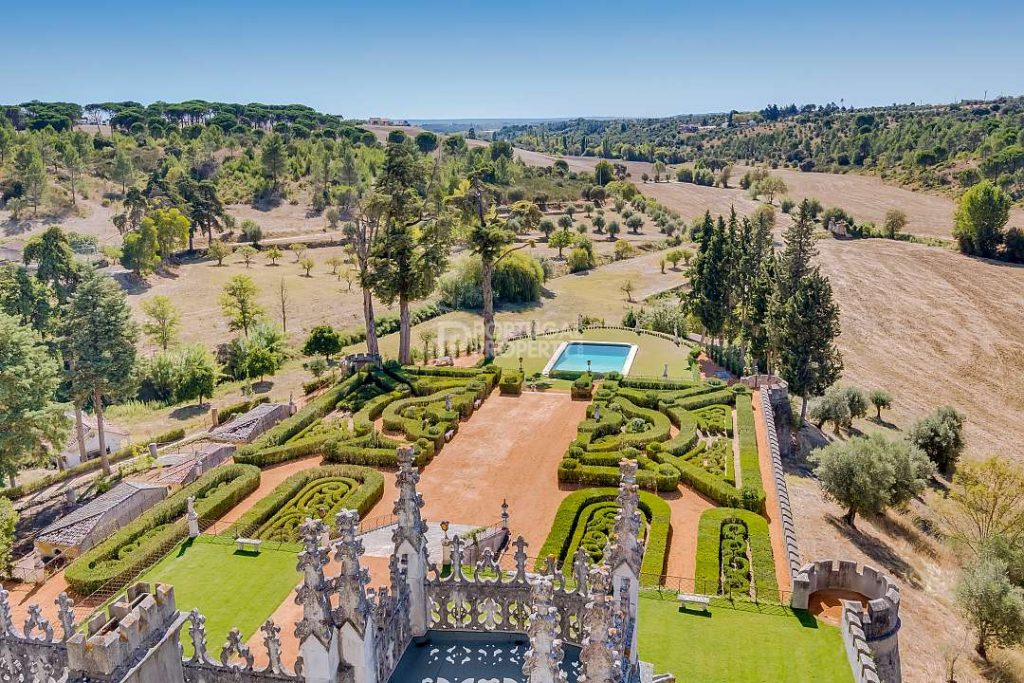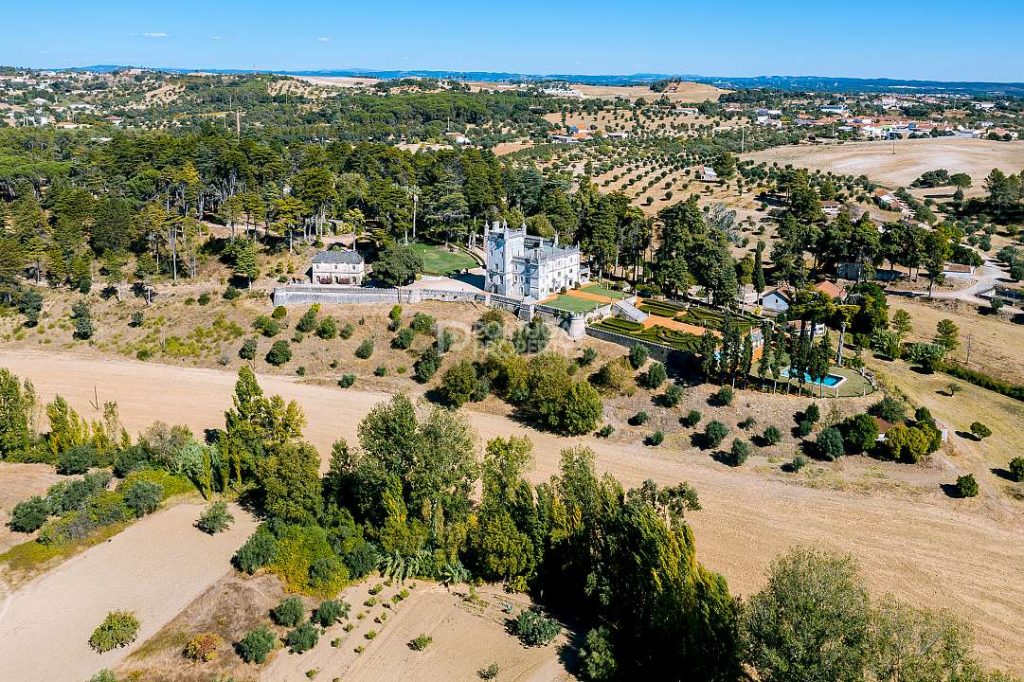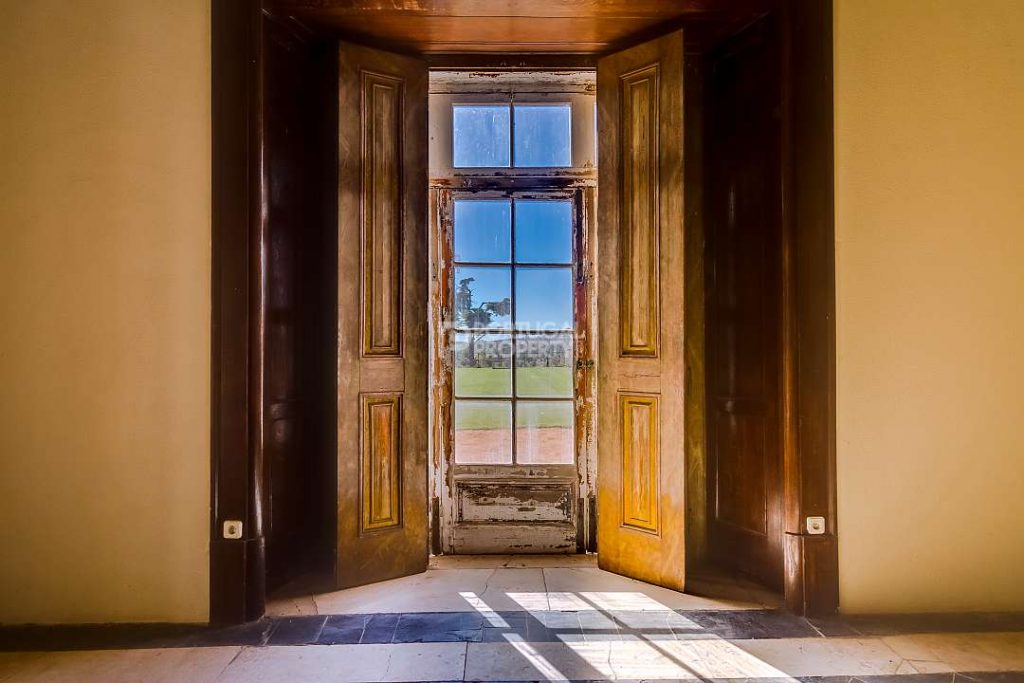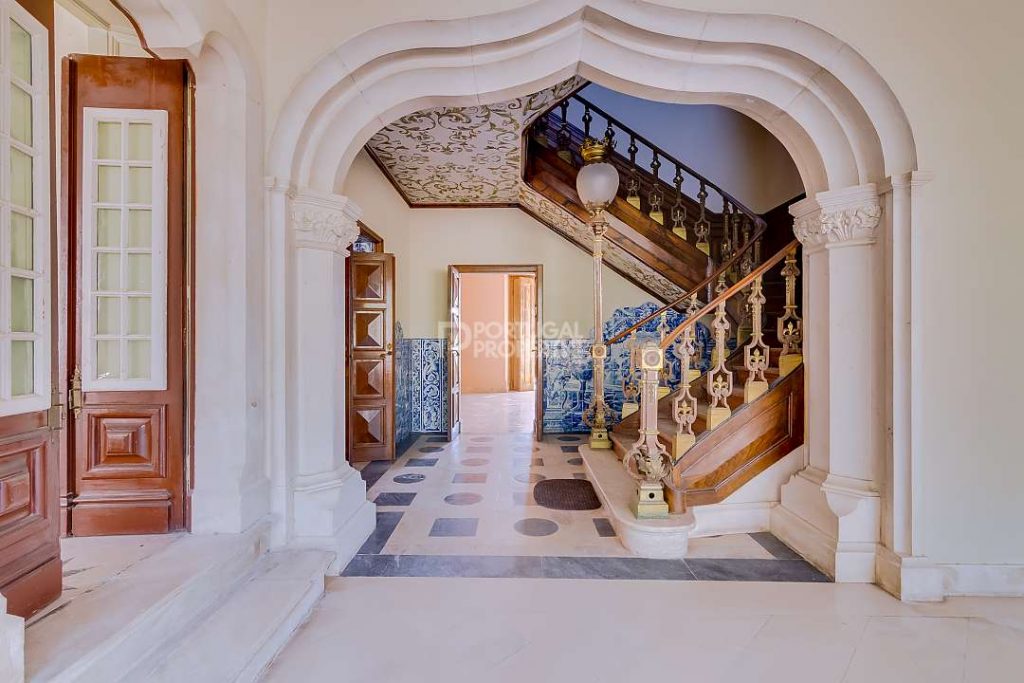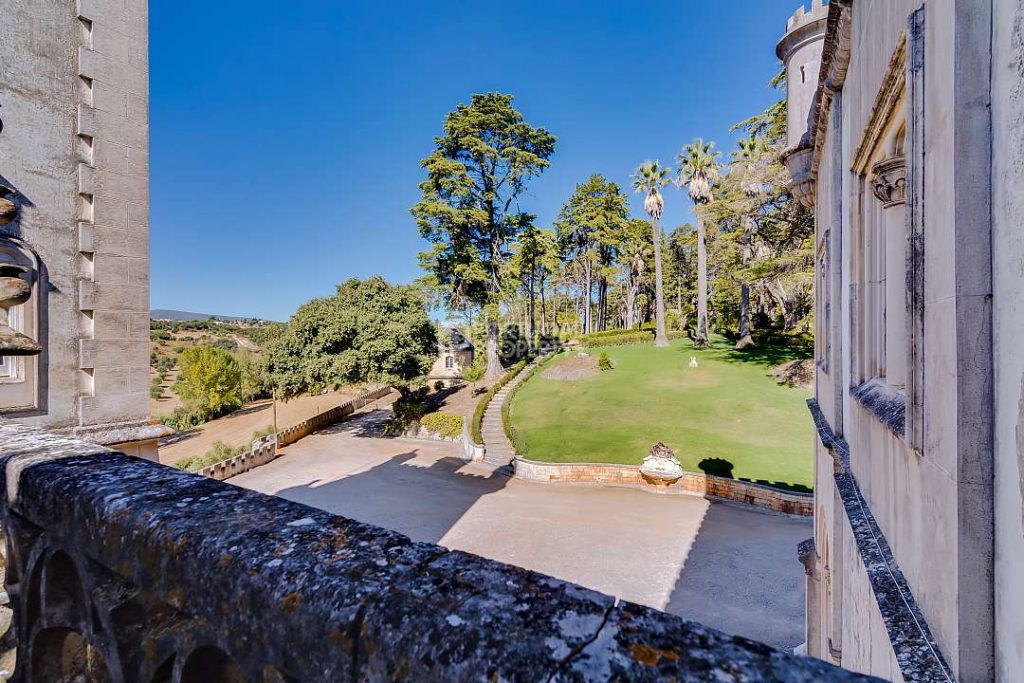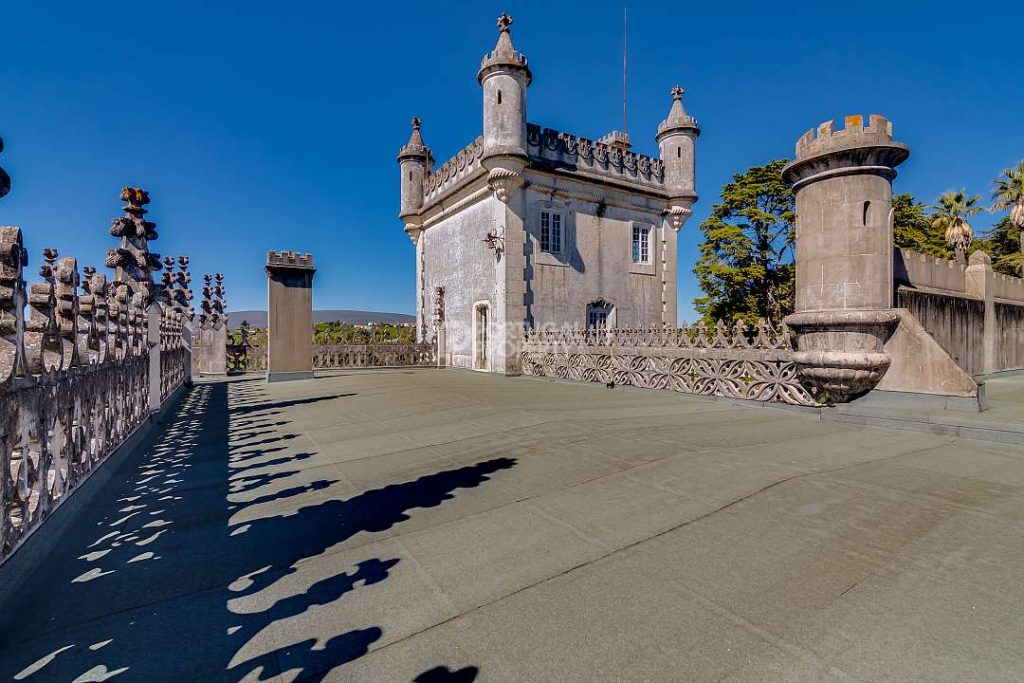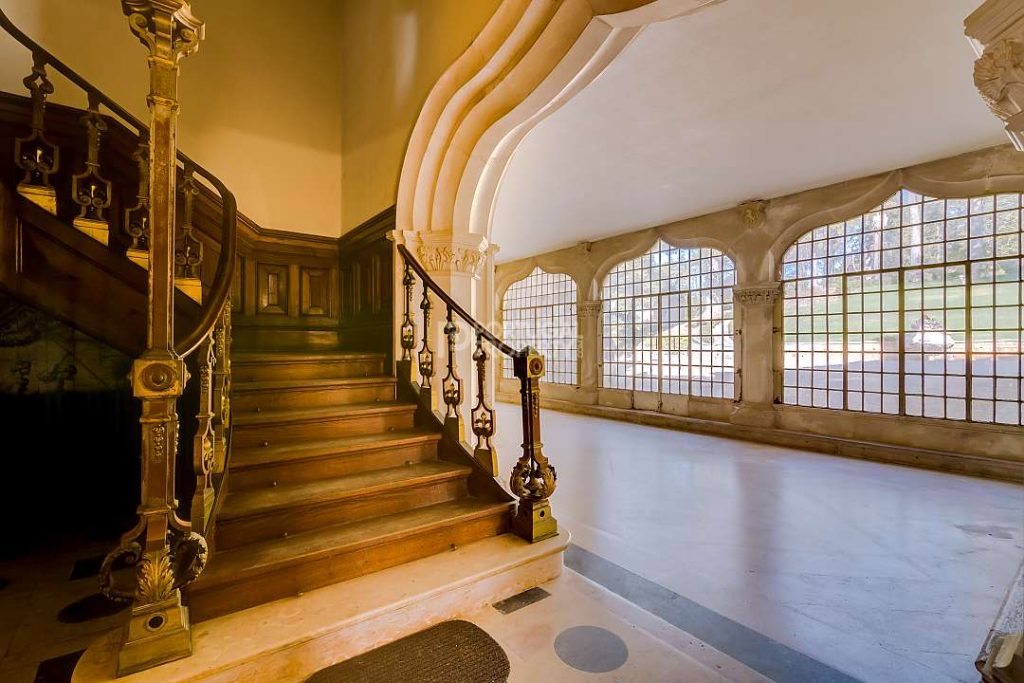
€6m Palace for sale in Portugal with BHHS Portugal Property
This Palace is For Sale with BHHS Portugal Property
The history of this space is closely related to the history of its owners and residents. It was they who, over the years have influenced the estate since its foundation up to this day, by building, rebuilding, modelling and renovating a space, making it their own, according to their fortunes, legacies and tastes of the time. There has always been a consonant aesthetic line, at various times, either with the owner’s criteria or marked by the choice of artists of recognized value, national or foreign, who contributed to make the Quinta da Torre de Santo António a recognized and admired space for its unique heritage importance.
Its geographical framework
Quinta da Torre de Santo António das Gateiras, today is known as Quinta da Torre de Santo António, or how its better known today, Quinta do Marquês, is located in the municipality of Torres Novas, Santarém district. Located in an ancient settlement area, as evidenced by the various archaeological remains found or the abundant Arab origin toponymy, it was conquered and reconquered, having obtained a charter in 1190 by King D. Sancho I. The area, which would have been an important point of supply for the royal stables and inns for the travellers that passed by, was occupied mainly by olive groves and cereals production. These characteristics and the fact of its proximity to Lisbon will have privileged the appearance of some estates, which, belonging to a closely related elite, will have contributed to the socio-demographic development of the region. Having almost always been tied to royalty – by possession, dowry, or donation – Torres Novas maintained a relationship with some social figures, thus attracting owners of an elite that, from the second half of the nineteenth century, provided some economic progress, boosted by the construction of new communication routes and based on some industrialization and agriculture, which mechanization will arise at this point in time. The Municipality is, therefore, a very attractive investment for wealthy families, an educated and knowledgeable social class, who are not afraid to dare in architecture and decoration, hiring several artists who will leave their brand for many years.
The Estate and its history
Quinta da Torre de Santo António das Gateiras, initially so-called as it is situated in the town of Gateiras, named after the abundance of wild cats in that area, was founded in the late seventeenth century.
Situated on a plateau in the countryside, the building stands alone on the hillside as an imposing architectural example, witnessing the various interventions it has undergone over the years and which have made it into the building that has reached our days, full of art history, as well as the marks left by its residents over the years. The construction of the first building in the same place dates, therefore, from the seventeenth century, commissioned by its first Morgado (1), the notorious legal consultant Manuel de Azevedo Pais. After ownership, including the plot of land, has passed through the hands of various owners, successive family inheritances and various transformations, which are not precisely documented, however, the building which had adopted the style of a chalet, with a built-in chapel, was sold to Alfredo Antas Lopes de Macedo was sold in 1876, a military man of great career, who in turn sold it in 1880 to the then Count of Foz, Tristan Guedes of Queiroz Correia Castelo Branco, who later became the first Marquis of Foz.
The first Marquis of Foz
The greater human intervention in the estate is due to the Marquis of Foz, an educated Portuguese who combined good taste and the knowledge of the best of what was produced in Europe in fine and decorative Arts, conferring to the then denominated Quinta de Santo António das Gateiras, an architectural and landscape wealth, unique in the Municipality of Torres Novas. The Marquis of Foz, who at the time was one of the country’s leading and wealthiest businessmen, also with a relevant presence abroad, had already been guiding, with some of the most qualified Portuguese artists, the remodelling and completion of Castelo Melhor Palace in Lisbon, acquired in 1889, later known as Palacio Foz and where he went to reside, where he assembled a remarkable collection of works of art which for years was considered one of the best national art collections. The first Marquis of Foz bought the Palace that gave the name to the 6th Marquise of Castelo Melhor, D. Helena, following the transactions of land and real estate for the construction of the railroad that would finish in Lisbon’s Rossio. The Palácio Foz, in Praça dos Restauradores, was, at the time and until the end of the 19th century, the most remarkable residence in downtown Lisbon, having undergone major renovations. After the acquisition by the Marquis, the Palace was again the object of internal and external renovation, continuing to be one of the most luxurious residences in the city, a magnificent cultural centre and one of the favourite places for the Lisbon elite to meet, at various parties and celebrations. However, soon after, in the twentieth century, the precarious financial condition of the Marquis of Foz, seriously affected by the crisis of 1891, forced him to discard his assets, calling an auction that lasted for ten painful days, inducing a constant coming and going of curious people and buyers, domestic and foreign, who went to the place to see or acquire some of the goods up for auction. The Marquis had accumulated in the palace an impressive collection of art with great commercial value, a collection that he was selling, along with the rest of the Palace, to pay off his debts. It is also attributed to him the well-known phrase “I am not a man without possessions, I am a man without credit”, that shows the disadvantaged situation in which he was. His name had ceased to be synonymous with large capital and large investments.
However, it is to Quinta de Santo António das Gateiras that, from 1901, he will devote all his attention and care, both in the construction of the new chapel, in the rebuilding of the house and in the creation of the wooded park, as well as in the modernization and operation of the rural part. His keen interest in the region had already been born years ago when, following the purchase of Quinta de Santo António das Gateiras, then used for short family stays, he acquired other neighbouring properties, dedicated to the most varied types of agricultural and wine production. And it will be in that farm where he will spend more time with his family and which will be his residence from the year of 1907, being this decision essentially due to the bankruptcy of his business activity, severely affected by the crisis of 1891 which made his public life in Lisbon very uncomfortable. The manor will thus become a “haven of tranquillity” for the Marquis also clearly depressed by the loss of his wife. It is known that, although they were not accurately recorded, there had been interventions in the then existing primitive manor, consisting of a chalet with two floors, attics and gable roof, covered balconies and a tower with four floors and four water roofs with attics. But it was during the years 1901 to 1907, under the direction of António Casimiro Simões, a friend of the Marquis of Foz, that the most expressive changes of the urban architecture of the manor were verified, in a complete transformation of the chalet that until then existed, a building almost utopian in character, with an artistic revivalism imprint of neo-Manueline and neo-Gothic, in vogue at the time. In this context, two southern Manueline windows from the 16th century, from the house of Mateus Fernandes, the architect of the Monastery of Batalha, and supposedly offered by King D. Carlos to the Marquis, as well as his two replicas stand out in the south façade.
The interior of the new building features a succession of thematically decorated rooms, with walls covered with tapestries from the Foz Palace, painted friezes decorated with vegetal motifs, or coffered ceilings decorated with swans painted by the renowned artist José Malhoa. Stairs decorated with wrought iron guards, steel and golden bronze with fl eurs-de-lis – heraldic element very present throughout the house – mark the sumptuousity and elegance of the space. Also, the use of tiles from the eighteenth century and others from the Fábrica de Faianças of Caldas da Rainha, as well as the Moorish-Hispanic motif is revealing of the eclecticism of the time. Already some years before, around 1896, a new chapel, dedicated to Santo António and integrated in a wooded park with varied species, had been constructed, in one of the highest spaces of the urban zone and separated from the residential building, having as main attraction a lake of sinuous format with about 1000 m2 . In the area north of this park, near the current main entrance of the Estate, the stables, coach houses and servants’ quarters were recovered. The new chapel, with a slight neogothic feature, very rare in Portugal, and with a marked verticality and harmonious proportion between the bodies, contained some valuable works of sacred art which remain there to this day. The entire outdoor garden area was also greatly modifi ed, having one of the gardens, called “Jardim Velho” (Old Garden), the signature of the then famous French gardener Pedro Maurier. Subsequently, in the late 1950s and early 1960s, new relevant changes occurred that gave the gardens their present confi guration. It should also be noted that, in the year 1900, authorization was granted for the exploitation of water resources in the area and, thus, to obtain potable water supply on the Estate, a cast iron pipe line was laid from the site of capture to the entrance of the estate, at a distance of about 600 meters – an element that remains to this day, having been used to supply the lake in the park.
Luigi Manini studies
The renovation of Quinta de Santo António, designed by the Marquis, is carried out at a time when architecture is of significant relevance in society, clearly representing the status, not only economic but mainly cultural, of the owners. Although a certain eclecticism appears in the constructions of that time, the individualism of their aesthetic choices clearly refl ects their social and intellectual character. So, wanting to leave a personalized mark on the estate, the choice of who will remodel it rests on Luigi Manini, a famous painter and set designer who had already worked in the Foz Palace on the occasion of celebration that took place there. Luigi Manini had made several projects for some capitalists around the Marquis of Foz, between farms and chalets on the slopes of the Serra de Sintra and was later invited to design the Buçaco hotel. The project he designed for the Quinta de Santo António reveals an aesthetic eclecticism, with notes of Portuguese Manueline and Renaissance styles and elements of English and French inspiration, thus respecting the wishes of the Marquis who wanted the same harmonious combination between the various styles and materials that made up his art collection. However, this project was eventually not followed, since the Marquis chose a smaller building, although inspired by Manini’s studies, especially in features like the fortress tower and the north façade of the main body, which he designed and built without the help of architects or masters, entrusting the conduct of the works to the already mentioned António Casimiro Serrão, his friend and compadre.
The following owners and their legacy
The Marquis of Foz remained as usufructuary of the Quinta until his death in 1917, a position that had been determined by his wife, the actual owner of the property, who was succeeded, on his death, by the third daughter of the Marquises. In 1907, she sold the farm to her brother, the third Count of Foz, and the name of the property was changed to Quinta da Torre de Santo António. Since the new owner was an agronomic engineer, he devoted some works to the structures related to the farming operation, which he developed, committing to the administration of the farm and its cultivated and wooded areas during the 27 years that have passed since the death of his father to his own.
In 1955, at the end of a court decision, Gil José Guedes de Queirós, Conde da Foz, one of the sons and direct heirs of the previous owner, gets ownership of the property. The Count of Foz was married since 1953 to Gertrude Schwetz, an Austrian lady, widow of Serge Voronoff (a physician of Russian origin, known worldwide for introducing and developing a technique of rejuvenation through the implantation of monkey glands).
From the beginning, the couple began deep renovations on the state, with a view to their permanent residence, maintaining, however, the refi nement introduced by the fi rst Marquis of Foz. The main wing of the house is visibly altered, a two-storey terrace is added, several rooms are restructured and modernized and bedrooms rooms with private bathrooms are created, a monumental marble fi replace from the Foz Palace is installed in the main living room, and various alterations are made in the exterior, of which stands out the installation of a swimming pool properly equipped with shower rooms and kitchen for picnics, at the same time the water supply system was also updated.
At this time, the couple provided memorable parties and stays at the estate, which was frequented by several notable personalities; some still remember the frequent visits of Salazar or Christine Garnier, the famous French journalist to whom he was close, as well as of King Umberto II of Italy and Elena Lupescu, wife of King Carol of Romania. On the death of the Count, her husband, in 1976, Gertrude Schwetz, inherited the property and married again in 1978 with Antonio Ramada Curto, and widowed again in 1987. The owner would die in the palace in 1993, sick and lonely and not leaving children.
Later that year, the estate passed on to the property of Dagmar Von Josipovich Serra di Cassano, Duquesa Serra di Cassano, universal heir and cousin of Gertrude Schwetz, who maintained it until 1996. In 1996, the property was sold to Hélder Correia who, in July 1996, auctioned almost all the invaluable furnishings of the residential building. In 1999, it was acquired by a company belonging to the SLN Group, later Galilei, which even announced the construction of a luxury tourism project and, since the end of 2017, has belonged to the company Apostalegre, SDC Investimentos Group. However, under the Municipality’s Master Plan, it has been partially classifi ed as an urban area, under which the owner is granted construction rights with some expression.
The current buildings
The whole main building is a testimony to the various renovations that exalted the space with objects of art and decoration. Each architectural aspect and each piece tells a part of the history of this place and each of its occupants. In the interior, on the north side, stands the atrium that opens to the great hall. In the atrium, the pavement consists of edged neo-Mudéjar style tiles, the walls are covered with tapestries and the coffered ceiling decorated with painted swans. On one of its walls remains a canvas with the arms of the family. In the great hall, there is a marble and bronze stove, possibly of French origin and a tribune supported by marble columns. The dining room, on the garden side, has a neo-medieval wood-burning stove with a painted ceiling with vegetal motifs.
The staircase leading to the upper fl oors features baroque tile panels from the fi rst half of the 18th century. On the upper fl oor, on the south side, the Manueline mullion windows stand out in two of the rooms; rococo style tiled fl oors in one of the corridors and a tiled bathroom in Art Nouveau, Sarreguemines manufacture. Both the tribune of the great hall and the steps of the stairs have bronze balustrades, possibly of French origin. From the furnishings, which were once highly praised, there are only left one golden bronze lamp with stained-glass windows, armorial wooden chairs, and a large framed canvas depicting the arms of the Marquis of Foz. The remaining furnishings, which included the collection of pieces from the Foz Palace, was mostly taken to auction in 1996. As an annexe, along the road, are the stables, with a plan of two rectangles attached and roofs of two waters of different heights, with attics.
Neo-Renaissance style ceramic tiles with the arms of the Marquis of Foz stand out, applied on the walls, as well as two beautiful glazed pottery high reliefs attributed to Bordalo Pinheiro, which represent the Annunciation to the Virgin and which were, somewhere in time, removed from the south façade of the house. The chapel is also a fi ne example of religious architecture. Located in the immediate vicinity of the palace, it has a Latin cross shaped plant. The main façade has an angled gable, an axial portal with broken arch, archivolts and a rose window. On the back façade, the faceted apse has broken arched windows. There are also three-sided side facades with stepped buttresses, with broken archways. The interior of the chapel reveals an altar in wood, neogothic style, polychrome stained glass, and panelling decorated with angels and fl eurs-de-lis framed by counter-curved arches. Contrary to what happened with the palace, the filling of the chapel remained until today, is possible to observe all the elements gathered by the first Marquis of Foz. At the altar, a wooden altarpiece presents to the visitor the image of Saint Anthony, the patron saint of the estate and the chapel. This image, with 1.10 meters of height and date of 1898, having been made in the Fábrica de Faianças of Caldas da Rainha, has the signature of Rafael Bordalo Pinheiro. The chapel also houses the plaster sculptures of the Sacred Heart of Jesus, St. Francis of Assisi and St. Francis de Sales, brought from the chapel of the Foz Palace; and still a seventeenth-century image of Santa Paula of Rome, with the habit of the Order of St. Jerome. From the sculptures in the chapel stands the life-size image of the Lord of Passos, signed by Father João Crisóstomo dated 1767. The fact of having face, hands and feet executed in a polychrome tin make this sculpture unique and a national reference.
The landscaping
The palace is surrounded by gardens and woods, whose organization has also been cared for by its successive owners, as they are an important aspect of the property valuation. The vegetation is made up of several native tree species – such as the Portuguese oak, holm oak, cork oak, olive tree, meadow pine and wild pine, ash, chestnut, black poplar, the alder and the willow, the latter on the banks of the watercourses; and Mediterranean species of shrubs such as the kermes oak, the arbutus, the pomegranate, the euphorbia, the rosemary, the honeysuckle creepers, sarsaparilla and aromatic herbs such as oregano, calamine, thyme, gall of the earth (Centaurium erythraea). There are still two imposing cedars planted at the beginning of the path leading to the chapel and a giant cedar that is thought to have been planted at the time of the founding of the morgadio and which should be one of the oldest cedars in Portugal.
MAP BELOW


